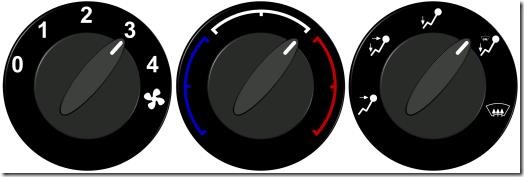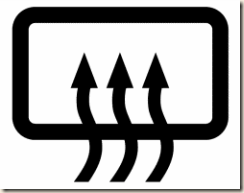 This is an old article from 2013, but it is due an update. When I originally published it, one of the show-me-tell-me questions was:
This is an old article from 2013, but it is due an update. When I originally published it, one of the show-me-tell-me questions was:
Show me how you would set the demister controls to clear all the windows effectively. This should include both the front and rear screens.
At the time of updating, the relevant show & tell questions (they changed the name) are:
When it’s safe to do so, can you show me how you’d set the rear demister?
When it’s safe to do so, can you show me how you’d demist the front windscreen?
For the windscreen – that’s the one on the front of the car – the universally correct answer would be that you’d switch the airflow to blow out of the vents on the rear of the dashboard up at the windscreen, turn up the fan speed, and increase the temperature of the air from these vents. That would work for any car, although the actual knobs to twist and buttons to press will vary from model to model.
For the rear window, you’d turn on the electric heater that warms those little metal wires stuck to, or embedded in, the glass. There will be a button somewhere on the dashboard that turns it on and off.
You will note that the original broad question has now been changed to two rather more specific ones. This is relevant, because most newer cars also have air conditioning, electrically heated front windows, and often a button labelled as “MAX”, which turns everything on to demist all the windows very quickly at the same time. One press and you turn on the front and rear window electric heaters, the air conditioning, and redirect the hottest air possible at the windscreen (and often the side windows, as well, if your car has that feature).
When asked the original show-me-tell-me question, operating the MAX button was a perfectly correct response – as were playing around with the air flow controls, using the heated front windscreen if you had one, and turning on the rear window heater. However, with the much more specific Tell questions currently used, pushing the MAX button isn’t strictly the right response to either of them. It is also worth noting that whereas the original question would have been asked whilst stationary, if either of these new ones are asked, it will be while the candidate is driving. Ever since they started doing it this way, I’ve had nightmares about people fiddling with buttons and dials while taking a bend and losing control (I know the examiner would prevent that, but at the very least it would result in a test fail).
Arguably, operating the MAX button is a satisfactory response to either question, because it will achieve the desired result. But it is technically not the correct response if you’re being pedantic about it, because it does several other things at the same time.
It makes sense to understand all the controls rather than just blindly push buttons and twist knobs. If nothing else, if you inadvertently turn the car into a sauna, you ought to know how to turn the temperature back down again – and you’d be surprised by how many people can’t work out for themselves that if you turn something on by pressing a button or flicking a switch, you can usually turn it off by pressing the button again, or flicking the switch the other way. It also means that if you respond to the examiner’s question by pressing the MAX button, you’ll probably be able to recover if he specifically asks you to demist either the front or back – but not both.
How does the air-blower demist windows?
It involves a bit of science, but it is enough to know that hot air will demist windows, whereas cooler air probably won’t.
The reason it works is down to relative humidity. Air can hold water vapour as a gas, but if the amount of vapour reaches the maximum that the air can hold, it precipitates out – condenses – as water droplets. That’s the “mist” on the glass. The problem is that the maximum amount of vapour the air can hold before condensation occurs gets less and less the colder the air is. If you refer to water vapour in air as the “humidity”, then the amount of vapor relative to the maximum possible is the “relative humidity”. In summer, a relative humidity (RH) of 70% might feel horribly sticky and sweaty – but there’d be no condensation. In winter, you can easily get 100% without feeling it because there’s a lot less moisture there– but since there’s no room for any more vapour in the air, any extra causes condensation to take place. Think of it as a bucket overflowing, where the colder it is, the smaller the bucket is.
What happens is that on cold mornings, with the air at – or very closer to – 100% RH, as soon as you get in the car, breathing and perspiring, you overflow the bucket and condensation takes place. You see it on the glass as mist, but everywhere feels slightly damp. When you initially turn on the heater, it is blowing cold air, and if anything you get even more misting. But as the car warms up, it starts to blow warmer air. This warm air can hold more water vapour, and it evaporates the mist as it blows across it and keeps hold of it.
What does the air conditioning do?
Air conditioning (A/C) units pass the air over a radiator filled with coolant – just like what you have in your fridge at home. If you look back at what I said about humidity, above, you can probably work out that if you cool very moist air, you send it above 100% RH. The excess moisture – and if you cool humid air at 30°C down to 8°C, there’ll be a lot of it – condenses out (usually as a pool of water under your car in summer if you’re stopped), and much cooler and drier air is blown into the car. You can play around with the temperature of the air that is blown in by passing it over the heater radiator, so you have crude climate control.
Since it removes moisture, A/C is extremely efficient at demisting and preventing further misting.
How do the heated windows work?
In a similar way to the air blower. As they heat up they create an area around the metal wires which is warmer and so the mist evaporates back into the air. They work best in conjunction with the car heater, which heats the bulk of the air in the car, and which can then keep hold of the vapour, preventing condensation. They work even better with the A/C, because it strips the vapour out and dumps it outside the car. The MAX switch activates everything in one go.
How do you control these features?
It varies from car to car, but for the heater blower, there will be several rotary controls usually located in the centre of the dashboard and below the level of the steering wheel.

One of them controls the speed (and noise) of the fan, one controls the temperature (blue is cool, red is warmer), and another allows you to select which vents and grilles the air will be blown through (at your feet, at your face, at both, or at the windscreen – possibly with other combinations).
Higher spec cars may have digital temperature displays, and some will have independent control for each side of the car. Some will even have controls in the rear for back seat passengers.

 The heated rear window button will have an icon like the one on the left, and the heated front windscreen will have one like that shown to the right.
The heated rear window button will have an icon like the one on the left, and the heated front windscreen will have one like that shown to the right.
The air conditioning will be activated with a button or switch marked A/C, and the MAX button (which activates all of these features) may also have one of the window icons.
Isn’t the heated windscreen for de-icing?
Not specifically, no. It serves the exact same purpose as the heated rear window – to demist. However, every demisting feature in the car can also de-ice if necessary. Even blowing cold air can lead to de-icing if it isn’t too cold, because the air passing through even a cold car is still warmer than that outside. However, a heated front window is noticeably useful at de-icing since that’s the very window that needs de-icing the most.
Having said that, a heated windscreen is only good at melting frost or dislodging a thin layer of rimed ice. If you think it’s going to get rid of a couple of inches of snow, think again. It doesn’t actually get that hot – if it did, it could cause the glass to shatter.
Why do my windows steam up in summer if it’s been raining?
That’s because water cools as it evaporates. If it’s already humid when it rains, the air passing over the windscreen evaporates the rain drops, so you get cooling around them. The humid air inside the car is then above 100% RH close to these spots on the windscreen, and condensation occurs. You usually see it around spots of rain.
You can also get it if you’ve had the A/C on. It cools the windscreen right down, so when you turn the A/C off and humid air gets back in, the cold zone near the glass sends the RH there above 100% and condensation occurs. In this case, misting is more uniform, but often concentrated on the lower part of the windscreen where the A/C has been blowing.
So what should I tell the examiner on my test?
Your best bet is to answer the question he’s asking you. If he asks how you demist the back window, operate the heated rear window switch or button. If he asks how to demist the front, either demonstrate how to redirect the air flow and increase the temperature and fan speed, or operate the heated windscreen button or switch (if your car has it).
In Nottingham, examiners have not been querying use of the MAX button, so use it by all means – but just make sure you know how to activate just one of the features as necessary if your examiner presses you on the subject. You are being tested on “safe driving for life”, so you ought to know what the buttons do anyway – you’re going to need to if you pass.
Since these questions are asked while you’re driving (and since you’ll be driving when you use them once you pass), be careful not to stare down and lose control of the car.